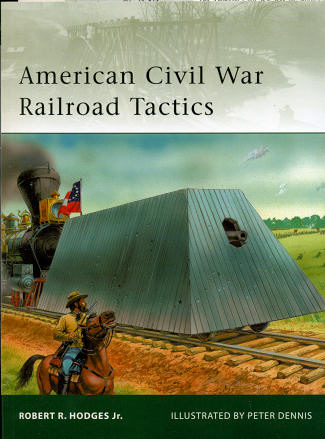 The
American Civil War is considered by many to be the first modern, technologial
conflict. It is here that numerous innovations and ways of conducting battle
were used, many which were used in following global wars and some of which are
still relevant today. It was the first war in which railroads played an
important part. Both the North and the South had rail lines and some systems
operated between the
border
states
prior to the war.
The
American Civil War is considered by many to be the first modern, technologial
conflict. It is here that numerous innovations and ways of conducting battle
were used, many which were used in following global wars and some of which are
still relevant today. It was the first war in which railroads played an
important part. Both the North and the South had rail lines and some systems
operated between the
border
states
prior to the war.
Railroads were used most often for the rapid
deployment of goods and troops from one area of battle to the other. Some were
actually used as mobile artillery lines with large guns or mortars on flat cars.
These were more effective that one would originally think, though as often as
not, these large guns were pretty well fixed so were unable to be even more
effective. The mortars, however, were more mobile than the guns and in several
cases played important parts in the outcome of battle.
As important as having the railroads were to
each side, equally important was the ability to either destroy or rapidly repair
the infrastructure. Often times bridges were destroyed, rails and roadbed
torn up or damaged, so having the ability to quickly bring these
destroyed areas back into service was very important. Both sides had able civil
engineers who were able to develop quick and effective means of restoring
bridges and rails back to operating condition.
In this book in the Elite series, author Robert
R. Hodges Jr covers all of these aspects of the railroads at war from the
development of rail guns to instances of moving troops into and out of battle as
well as what it took to wreck, repair and run the railroads during the war.
There is also a section on hospital trains, a most important part of the
function of the railroads in getting the injured to medical care (such as it
was). All of this is superbly illustrated with period photographs and drawings
as well as the art work of Peter Dennis.
In all, it is a book that I found particularly
fascinating to read and one that I can easily recommend to you.
November 2009
For more on the complete line of Osprey books,
visit www.ospreypublishing.com. In the US, it is
Osprey Direct at 44-02 23rd St, Suite 219, Long Island City, NY 11101., where you can
get a catalogue of available books.
If you would like your product reviewed fairly and quickly, please contact
me or see other details in the Note to
Contributors.
 The
American Civil War is considered by many to be the first modern, technologial
conflict. It is here that numerous innovations and ways of conducting battle
were used, many which were used in following global wars and some of which are
still relevant today. It was the first war in which railroads played an
important part. Both the North and the South had rail lines and some systems
operated between the
The
American Civil War is considered by many to be the first modern, technologial
conflict. It is here that numerous innovations and ways of conducting battle
were used, many which were used in following global wars and some of which are
still relevant today. It was the first war in which railroads played an
important part. Both the North and the South had rail lines and some systems
operated between the